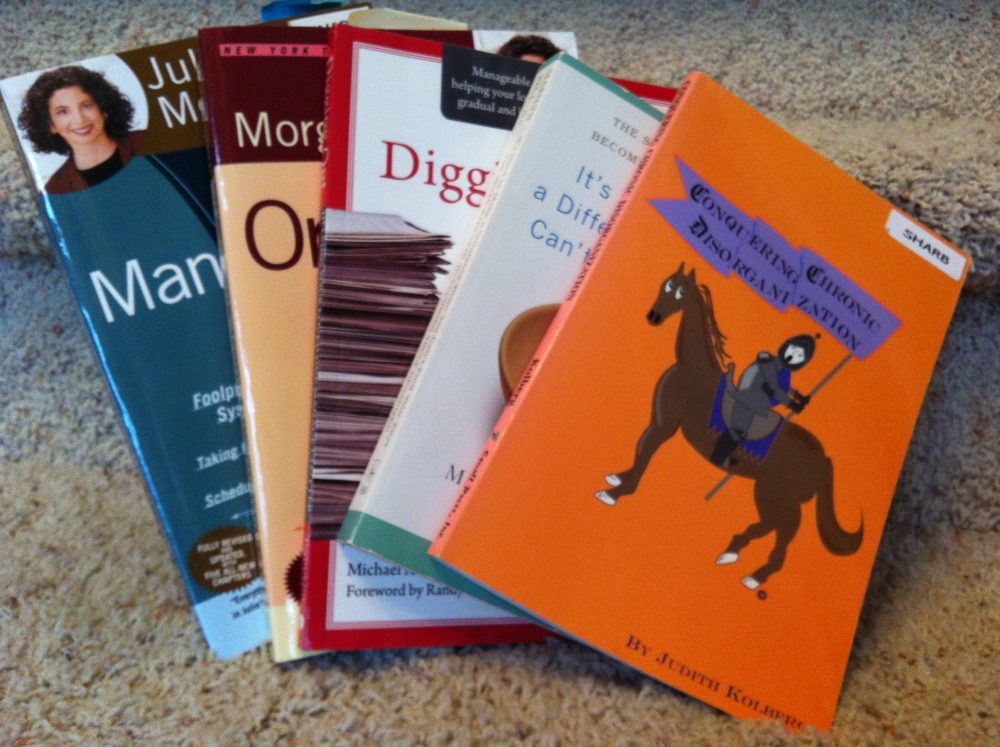 I’ve read a lot of books about organizing and related topics over the years and am often asked to recommend books I’ve found especially helpful or insightful, so I thought I would share my five favorite organizing related books with you.
I’ve read a lot of books about organizing and related topics over the years and am often asked to recommend books I’ve found especially helpful or insightful, so I thought I would share my five favorite organizing related books with you.
These books are listed in no particular order and I have given a brief explanation of why I they are on this list.
Organizing from the Inside Out, Second Edition: The Foolproof System For Organizing Your Home, Your Office and Your Life by Julie Morgenstern is an outstanding introduction to getting organized and is just as useful for disorganized individuals as it is for professional organizers. In this book Morgenstern examines the causes of clutter on three different levels: technical errors, external realities, and psychological obstacles and also summarizes how to combat disorganization through use of her steps: Analyze, Strategize and Attack. Morgenstern further subdivides the Attack phase into five steps, which can be easily remembered through her SPACE acronym: Sort, Purge, Assign a Home, Containerize, and Equalize. I still rely on this acronym to this day when explaining the organizing process to my clients.
Conquering Chronic Disorganization 2nd Edition by Judith Kolberg, is one of the first organizing books I read. I recall checking it out of the local public library and being very curious about the small orange book with the unusual illustration on the cover of a knight sitting backwards on a horse. At that point I had no idea there were different types of disorganization or that “chronic disorganization” would eventually become a passion of mine. I remember being fascinated by Kolberg’s methods for addressing chronic disorganization and I began to use these methods with one of my first clients, who clearly fit the chronically disorganized profile. As my clientele grew, I recognized that many of my clients were “chronically” disorganized and I sought out Kolberg’s What Every Professional Organizer Needs to Know About Chronic Disorganization. This slim little book, only 70 pages long, is one of the books I consider required reading for organizers I mentor.
Time Management from the Inside Out: The Foolproof System for Taking Control of Your Schedule and Your Life by Julie Morgenstern – Like Organizing From the Inside Out, Time Management From the Inside Out is an organizing classic, as it eloquently introduces the topic of and many facets of time management. My favorite parts of this book are Morgenstern’s discussion of making time tangible, her discussion of “Understanding [One’s] Unique Relationship to Time” and her discussion of time mapping. Morgenstern understands that one of the reasons that time is so difficult for many of us to reign in is that it is “invisible, “utterly amorphous” and even “slippery and elusive.” She encourages her reader to make time more tangible by comparing time to a container, in particular a closet. I find myself referring to this closet analogy with clients and it is interesting to watch their faces, as they are introduced to a whole new way of looking at their time. Though this book is a great introduction to time management, I would suggest reading it in conjunction with David Allen’s Getting Things Done: The Art of Stress-Free Productivity
for a more complete picture of gaining control over one’s time.
It’s Hard to Make a Difference When You Can’t Find Your Keys: The Seven-Step Path to Becoming Truly Organized by Marilyn Paul, Ph.D.is the book that stands out for me as being truly exceptional in that it best helped me understand the nature of disorganization. I especially appreciate Paul’s explanation of the “The Rhythm of Organizing” because it reminds and reinforces that organization is not a static state, but is instead a flow that we will move in and out of again and again throughout our lives.
Digging Out: Helping Your Loved One Manage Clutter, Hoarding, and Compulsive Acquiring by Michael A. Tompkins, Ph.D. and Tamara L. Hartl, Ph.D. rounds out my top five. As an organizer who has developed a specialty in working with those with hoarding tendencies, I often receive calls from concerned family members who don’t know where to start or what to do about their loved one’s hoarding problem. Digging Out is the book I refer these individuals to more often than any other. This book differs from other hoarding books available in that it is written specifically for “family members of people who hoard [especially when the hoarding individual]…has little or no insight about the problem and therefore ha[s] refused treatment or help.” The primary factor that distinguishes Digging Out from other books related to hoarding is that the focus of this book is not on “curing” the individual that hoards, but instead on implementing harm reduction techniques that will result in a safer existence for the individual that hoards.
I look forward to hearing what you think about these books, as well as what books might be on your list…
Love all five books that you reviewed, Andrea. They are classics. Some of my favorites include:
“Organizing Plain & Simple” – Donna Smallin
“One Small Step Can Change YOur LIfe” – Robert Mauer, PhD
“Never Be Late Again” – Donna DeLonzor
“To Buy or Not to Buy: Why We Overshop and How to Stop – April Lane Benson, PhD
“The Other Side of Organized” – by me, Linda Samuels
Linda, you’ve listed more favorites! I am not familiar with Robert Mauer’s book. I’ll have to check it out. Thanks for sharing.
You will LOVE Mauer’s book! It’s based on the Japanese principle of “kaizen,” which has to do with continuous improvement in small, manageable steps. ICD subscriber, Kathy England presented a few teleclasses on this, which is how I heard about the concept and the book.